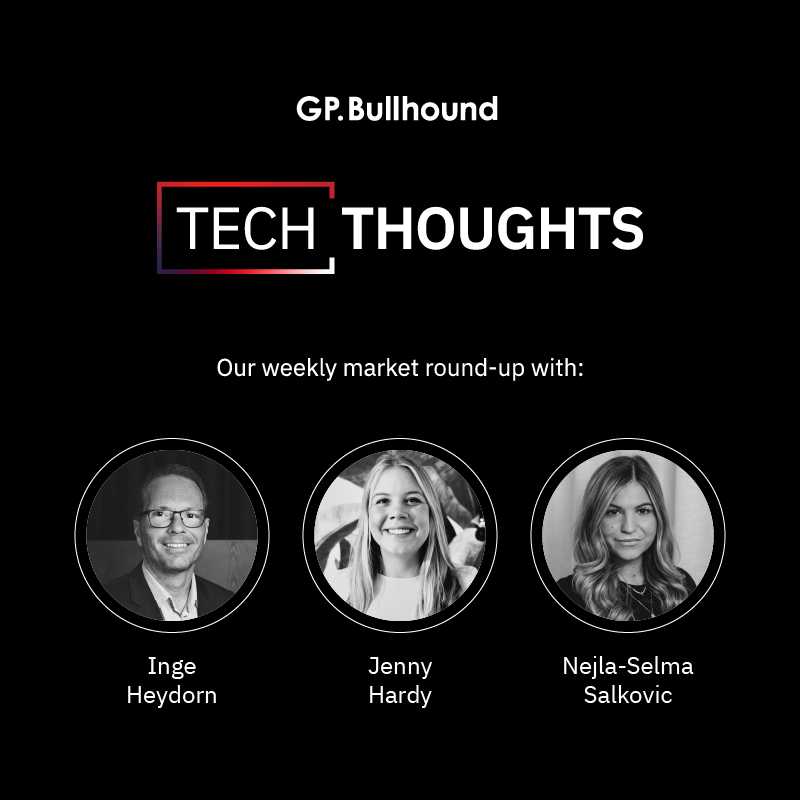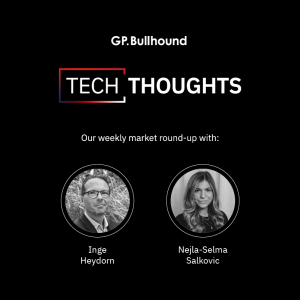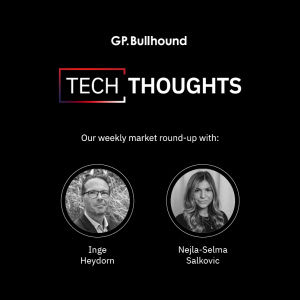Tech Thoughts Newsletter – 4 November 2022.

Conclusion/key takes
The macro-economic slowdown is clearly spreading and now affecting all verticals in tech. Consumer focused tech and SME exposed software are still the most affected for the moment and especially demand in Europe. We are also starting to see consolidation in software spend towards stronger vendors vs niche products. We expect to see a wider difference between how companies perform during the coming 12 months driven by individual business execution at what is undoubtedly going to be a difficult time for all businesses.
- Smartphone and PC markets are probably quite close to the bottom but inventories will still need to be adjusted during 1H2023.
- Cloud investment still strong but there may bel pause driven by technology shift (new platforms, CPU, memory upgrades)
- Software/cyber security demand is still there but cycles are lengthening and consolidation happening – again we think in software particular, sales execution will be key
- Strategic long-term investments in semis continuing with more capacity still needed at trailing edge nodes
Portfolio: The week has played out as expected which means that we have not made any major adjustments to the portfolio at a company level.
PC and handsets – weak but signs of bottoming
- Qualcomm, Qorvo, Skyworks (not owned – We have very little handset exposure across the portfolio) – we know there’s an inventory correction going on in the handset market (particularly within China/Android), but the magnitude of Qualcomm’s guided miss took us somewhat by surprise. Looking in the details though, we think there are some reasons to believe that we may be close to the bottom of the inventory correction in Q4/Q1 next year. For Qualcomm, it’s benefiting as Apple’s modem supplier – where it’s the technology leader (indeed, Apple has been trying – and struggling – to do this themselves). It’s also the case that this technology becomes increasingly relevant in the world of connected cars, which we’ve written a lot about.
- Qorvo also indicates that 4Q will be the bottom for them and their Chinese business will grow in 1Q.
- Lenovo (not owned) gave us a much better-than-feared view of the PC market – where they are the leading player. PC sales were down 11% Y/Y driven by weakness for consumer PC while high end premium sales were still up 4% Y/Y and gaming was up 34%. And we’d note while finished inventory was up on their balance sheet, it’s not at levels that would be concerning for us.
- AMD (owned) PC sales were down 40% Y/Y and deteriorated during the quarter – they’re very clearly shipping below demand for the moment (which we think is more like -15% yr/yr. We talk about it related to NXP below – but we’d note positively that semis businesses are very sensibly managing channel inventory levels, which is positive for the long term health of the industry – and should prevent any dramatic downturn from here.
Datacenter – strong demand continues, driven by US hyperscalers – we acknowledge we may see a pause in demand around tech upgrades but no panic for us
- AMD (owned) – North America cloud is still very resilient. The market continues to be worried around a slowdown in datacentre capex – we’re not very concerned about that and think any pause we do see is temporary – as we await new product upgrades across the board – Genoa as a new platform, PCIe 5.0 standard coming in and higher density DDR5 memory coming into the mix. The company is continuing to gain share at hyperscalers and also gaining a footprint on the corporate side.
- Arista Network (not owned) , which sells switches into hyperscalers (Meta and Microsoft where we know – from last week – datacentre capex remains strong) revenues jumped 57% year-over-year, and nearly 12% from last quarter, to land at a record $1.177B. So beating on the quarter and guiding better. The company is also stating that they are under shipping demand and has felt no slowdown yet.
- Lenovo (not owned) reported record level of cloud server and storage sales and even indicated better demand as the quarter played out. The company also states that they are seeing continued strong demand for Enterprise/SMB, not just in clearing its backlog, but also in fresh load. To quote them “I would say that we continue to see even stronger demand in the quarter that we’re in right now. So this isn’t a slowdown”.
- Super Micro (not owned) pre-released their strong numbers and the results were even stronger. The company gave also a very strong outlook for the coming quarter. During the quarter U.S. sales grew 131% Y/Y being the key engine of growth. We believe the company is clearly gaining market share but also that the underlying market is strong. The company also highlights that we are in a product transition period in terms of key components from AMD, Nvidia and Intel.
Automotive – still strong demand, still supply constrained
- NXP (owned – and also autos read to IFX) – beat Q3, a slightly damp Q4 guide but a very good conference call around both auto end market demand and how NXP are managing their business through the cycle: auto demand (50% of NXP revs) still far exceeds what they can supply, and that’s led to a completely different risk dynamic for semis with OEMs signing up to long term, non-cancellable/returnable contracts – NXP is effectively sold out through 2023;
- More broadly in semis it’s striking how much the management teams are focused in managing any down cycle or slowdown in a much more conservative way than we’ve seen in the past. For NXP this means managing its distribution channel (55% of sales and very China-focused) with much tighter inventory levels than we’ve seen in the past – so they’re maintaining 1.6 months of channel inventory vs 2.5 months we’ve seen in prior cycles. That effectively means $500m of revenues they could (and previously would) have recorded in Q4 as they kept shipping which they’ll now keep on their books in order to minimise channel inventory buildup/obsolescence if demand falls, and to potentially reship it to areas where there’s sell through. AMD had similar notes of conservatism – in not overshipping into 2023. All points to this being a slowdown and NOT the big downturn we’ve seen in the past in semis.
- Qualcomm (not owned) Automotive sales were very strong and the order book continues to grow fast. The company is today mainly exposed towards automotive connectivity which is becoming increasingly important (and where Qualcomm has tech leadership from its handset history).
- We’d note that auto semis are predominantly still built on trailing edge nodes and will almost certainly continue to be supply constrained – most of the old capacity has been repurposed or has gone away completely, and it’s very likely we need new capacity built (as Microchip note – further below).
Software – mixed – structural demand but execution dependent and signs of consolidation
- Hubspot (owned) reported strong results – growing 38% yr/yr cc – with strength in both new customer signings and spend within existing clients. This is impressive in the current macro environment where we would broadly expect new logos to be much harder to go after vs. expansionary spend within existing clients. They did comment, like others, that deals are taking longer to close, with more scrutiny and tighter budgets overall. Again though, a sense that software is helping increase productivity (in Hubspot’s case leading to better conversions and better customer experience/retention for its customers) – and so for those businesses that do have a unique product that is genuinely additive to their clients sales processes – demand looks to remain robust.
- Atlassian and Twilio (neither owned) both suffered guide downs and big downward share price moves – we expect that freemium models (Atlassian) will naturally be more vulnerable to the macro, and more broadly really think that a lot of the performance around software as we go into what is a very difficult time for businesses, will come down to the individual business execution and individual business models. We also note the relatively long sales cycles in software – likely some of these businesses still have a degree more pain to come around the ongoing budget tightening at their customers.
Cyber security – still a structural demand area but like broader software, vulnerable to consolidation of spend
- Varonis Systems (not owned) had a big miss in the quarter. Cyber security last quarter was mixed and this is the first notable read this quarter. They spoke of more scrutiny around deals, longer deal cycle and macro uncertainty – particularly in Europe. We think legacy on-prem enterprise software (which really Varonis is) will struggle in this period – with customers understandably reluctant to enter into a large license-based agreement in periods of macro uncertainty. We also wonder out loud if the competitive environment impacted Varonis in the space (Google/Mandiant acquisition addressing the same market). And its announced transition to SAAS compounds an uncertain P&L profile that investors will understandingly find hard to digest.
- Fortinet’s (not owned) Q4 billings guide was lowered given increased macro uncertainty and more uncertainty around the timing of large deal signing. Again, we recognise that the world looks rather different this budget cycle than it did last year for businesses around the world. In cyber, while the structural demand is undoubtedly there, we do see competitive risk – the last few years have seen a number of new entrants with niche products and easy deal sign-off, and there is certainly opportunity for consolidation of spend here.
Semiconductors/Semicap read – new capacity still needed, particularly at trailing edge nodes.
- Microchip (not owned) reported strong results and guidance – probably the strongest we have seen this reporting season. Their exposure towards industrial, automotive, aerospace and defense, data center and communications infrastructure end markets which make up 86% of net sales, remain strong, while consumer (mostly home appliances) was weak. The company is still not meeting demand and are constrained on the equipment side.
- Interestingly for us and for semicap readacross, Microchip is in the early stages of considering a 300-millimeter U.S.-based fab for specialised trailing edge technologies. “This fab project, if we decide to pursue it, would be intended to provide competitive growth capacity as well as geographic and geopolitical diversification. The availability of grants, subsidies and other incentives will all be important considerations in our analysis and will also help determine the location and timing for the fab.” Quite interesting that new fabs are being planned
- This is inline with our view that the underlying growth going forward will drive spending although the economic downturn is dragging down volumes short term.
Gaming – expect a title driven quarter
- Sony (owned) beat and raise – driven by music, and for us a standout performance in its semis business – where Sony makes CMOS image sensors which supply into Apple’s Pro – where demand has been strong. Sony continues to lead from a tech perspective in this area and while competitors are quick to catch up, the continued upgrade to the camera module from Apple continues to benefit Sony’s tech leadership.
- Gaming for Sony was ok – remember Sony raised prices in August which benefited the top line. Engagement was lower yr/yr – which isn’t unexpected and is part of the long term normalisation in trends post COVID. We continue to think the gaming market is very much title driven – Sony’s God of War was recently released with a strong reception and production targets into the year end indicate strong momentum from that.
- Talking of big titles… Activision Blizzard (owned) announced Call of Duty set a record for the biggest opening weekend with over $800m sell through – an astonishing number! Which will benefit Sony too.
For weekly insights on the latest market updates, please subscribe to our Tech Thoughts podcast.
For more information about Tech Thoughts, please visit https://www.gpbullhound.com/tech-thoughts/.
We provide investors with access to category leading technology companies, globally. Our assets under management have a total value of more than €1bn, and our limited partners include institutions, family offices and entrepreneurs. Learn more about our funds here.
Enquiries
For enquiries, please contact GP Bullhound’s Public Funds team at public.funds@gpbullhound.com.
About GP Bullhound
GP Bullhound is a leading technology advisory and investment firm, providing transaction advice and capital to the world’s best entrepreneurs and founders. Founded in 1999 in London and Menlo Park, the firm today has 12 offices spanning Europe, the US and Asia. For more information, please visit www.gpbullhound.com.

